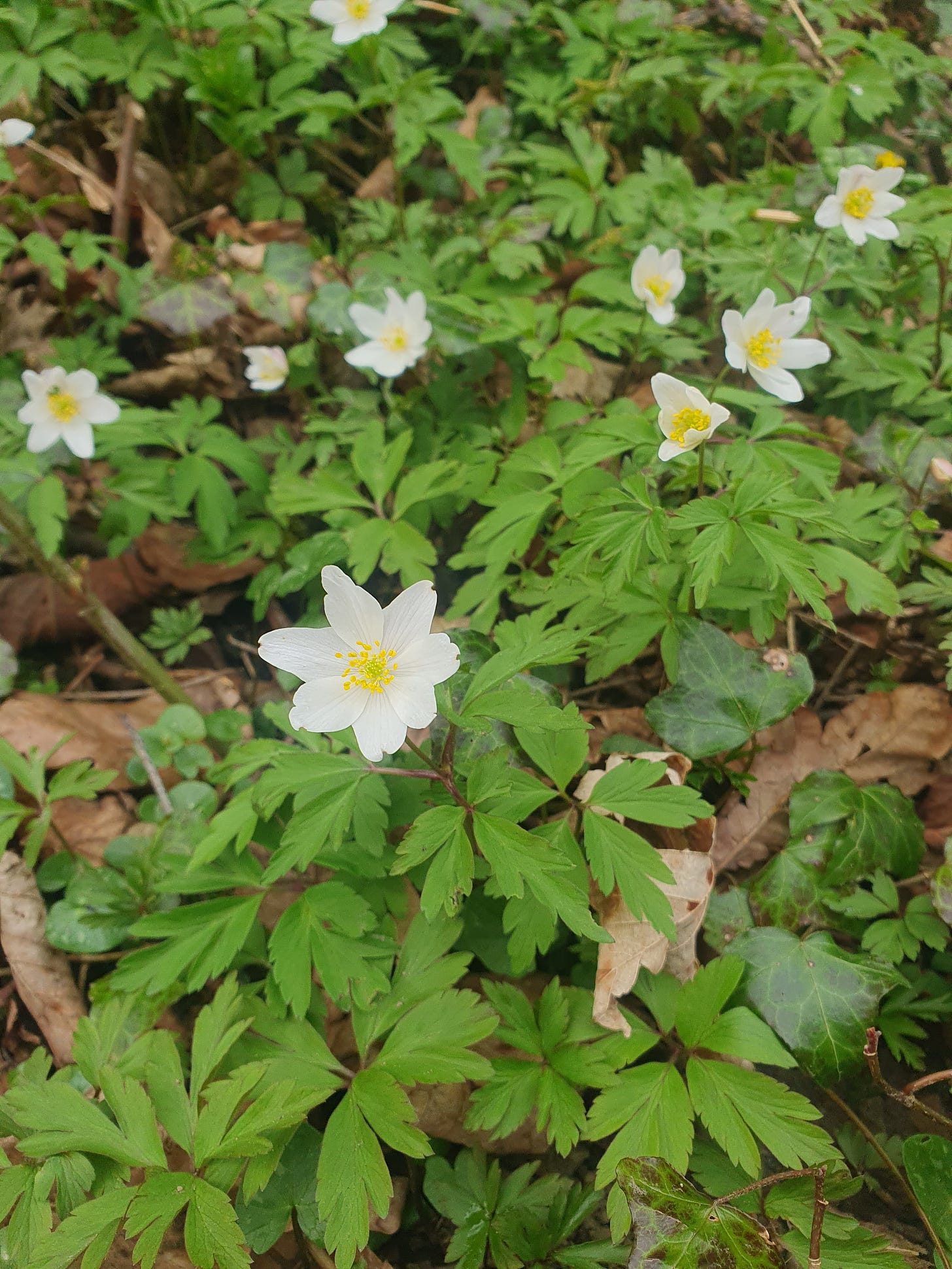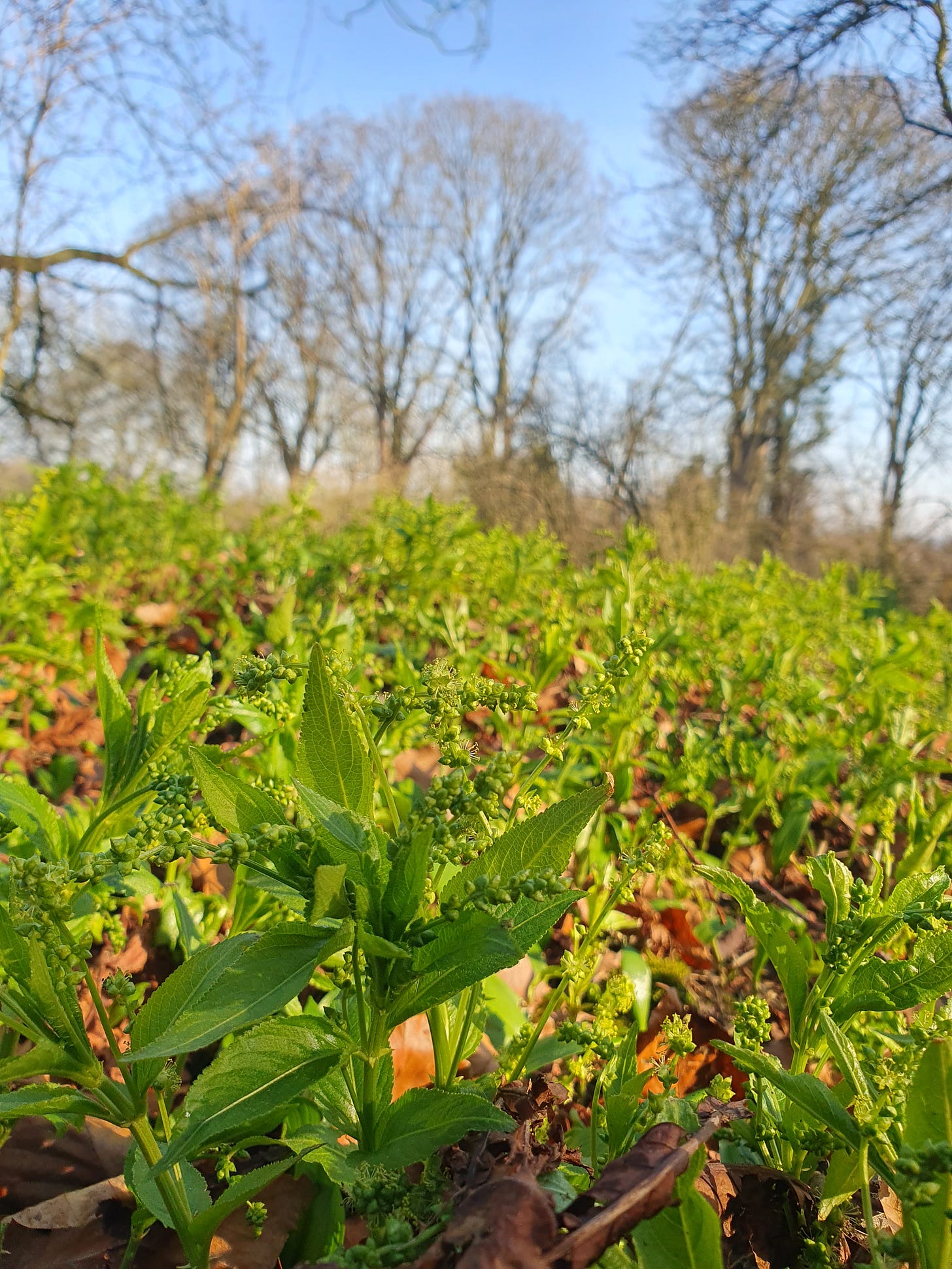Hello, my beautiful.
I can honestly say that last weekend - the first of spring - was one of my favourite weekends ever.
My husband (picture a tall, blond guy who looks good carrying binoculars) and I took a trip to Hebden Bridge in West Yorkshire and ended up stopping every five seconds to gasp and whoop at the first signs of the season.
We had just stopped for a swig of water when I suddenly found myself running towards the verge screaming:
“THE WOOD ANEMONES ARE HERE! THEY’RE HERE!”
I gesticulated wildly before Will added, “Oh, and there’s some dog’s mercury right behind it! This must be ancient woodland.”
There it was - proof that this stoic lawyer had been absorbing forest knowledge from his giddy green witch wife for all these years. I could have cried.

Meet me in the wildwood
Wood anemone and dog’s mercury are INDEED indicators of ancient woodland (as are wild garlic and English bluebells). Why? Because their root systems spread slowly through rhizomes, rather than through seed dispersal. This means they take centuries to colonise an area, making them reliable markers of undisturbed, ancient habitat.
But what exactly is ancient woodland?
Ancient woodland is a patch of forest that has existed since 1600 in England, Northern Ireland and Wales, or 1750 in Scotland. In 1600, Elizabeth I was coming to the end of her long and powerful reign while delicate saplings were first raising their heads, preparing their leaves to become the most potent woodland in the country. You know you’re in ancient woodland for several reasons – the sprouting dog violets pushing their delicate purple heads defiantly through the leaf litter, dog’s mercury unfurling a string of poisonous green-white flowers from its spear-like leaves, the oaks so gnarled and bent over one another that their trunks look ready to explode with age.
This habitat, however, covers just 2.5% of the UK, making it one of our rarest ecosystems and even more vital to protect.
Wood anemones are one of the first flowering plants of spring. In my eyes, they are like quartz crystals burst open; white stars about the size of a fifty-pence piece – and there are dozens of them studding this wooded hillside here in Hebden Bridge, alternating from dove-grey to snow-coloured as the dappled light makes them shine. In this hidden place of ancient lichens and mosses clustering at my feet, I can believe there is a secret world that opens up only to those who want to find it. Call it the Realm of the Fae or whatever you will, but there is a place the soul goes to when we are in the dappled light of ancient woodland that is not quite of this Earth.
And? What’s so special about it?
I’m typing this with a single raised eyebrow.
What on earth do you mean?
Ancient woodland is a living time capsule. The trees here have weathered storms that have uprooted cities and have stood firm through centuries of human (and wild) history. Unlike secondary woodland (younger forests that have regrown after human clearance in recent years), ancient woodland holds a unique ecological memory - once lost, it cannot simply be replanted.

Its soil is rich with fungal networks that glow and communicate below the fertile, moss-ridged soil. The wood’s hollows provide refuge for bats, dormice and owls, and its layered canopy shelters butterflies, beetles and rare lichens such as barnacle and lungwort lichens. The biodiversity in ancient woodland is unparalleled - many species that thrive here simply cannot survive in newer forests without their network of rare foodstuffs and habitat.
And yet, despite all this, ancient woodland continues to disappear at an alarming rate. In the past century alone, more than half of the UK’s ancient woodlands have been lost due to felling, fragmentation, conifer planting or degradation by pollution and development. The Woodland Trust says:
“Our ancient woods are crucial to the climate change effort. Ancient woodland makes up 25% of all UK woodland, but it holds 37% of all the carbon stored in woods and trees. It’s doing some serious heavy lifting.”
In spite of this (according to WWF), up to 70% of ancient woodlands in the UK have been lost or damaged.
They are rare and very, very special habitats. For us all, yes, but especially for the Pagan community.
Witching in the wood
Aside from the moors of Northern England, ancient woodland is the place I feel the veil between the worlds most keenly.

I dare anyone to enter an ancient woodland and not feel the potency of the magick laced within.
In my book, The Wheel: A Witch’s Path Back to the Ancient Self, I wrote about an encounter with ancient woodland over in Denby Dale, Yorkshire. Here, wandering once more with Will, we could have been under the watchful gaze of green woodpeckers and goshawks, dappled in the foliage light. But it was not just the flora and fauna that gave the wood away - it was a shift in the air. The woodland was like a reverse vacuum chamber; there was so much air and it was dense, as dense as the tree canopy which weaved over itself again and again to infinity. I almost felt my heart slow down. It’s as if our bodies have a primal reaction to it. When I’m in that space, everything feels connected. There is a stark remembering.
One of the commonalities across all Pagan beliefs is the idea that nature is sacred and we should treasure and conserve it at all costs, taking only what we need and giving back just as much (if not more).
Speaking on behalf of many Pagans, from the conversations I’ve had with friends and witnessing the stunned panic in the face of yet another road through precious habitat or another bird of prey’s nest destroyed, I will say that people who share this belief in nature often have to cope with despair. It is very difficult to live in a society that seems hell-bent on furthering humanity’s iron grasp on the planet and not listening to the pleas of the natural world.
It is our job as Pagans and stewards of the land to protect these woodlands and their delicate ecosystems that would take hundreds of years to reestablish themselves.
This is why so many witches, druids and animists seek out the old woods. These are places of communion - where the past lingers, where the boundaries between worlds feel thin and where nature’s voice speaks loudest.
Your magickal mission
Ancient woodland is sacred. It is your mission as someone in touch with the magickal and natural world to help the spirits of these woods.
So what can you do?

Visit them - walk the hidden paths of the ancient woodlands and learn their flora and fauna. Find ancient woodland near you (if you are based in the UK).
Protect them - if a local woodland is under threat, lend your voice to petitions and campaigns. Sign up to The Woodland Trust’s newsletter to be notified.
Plant more trees - while you can’t recreate ancient woodland, you can plant native trees to create future sanctuaries. We are currently just outside of planting season but you may wish to donate to charities that plant in winter or volunteer to help them throughout the year.
Learn their secrets - when you visit these sites, commune with the nature spirits that live there, meditate with the age-old trees and seek spiritual solace there. Ask them what they need and give back as you can.
The trees will thank you in their own quiet way.
I hope you have a gorgeous weekend. Be gentle with yourself as the new moon and solar eclipse rise today - the energies may be a lot, so this is the perfect time to seek out the woods and ground down into the many-layered earth.
Bright blessings,
Jennifer x
P.S. Thank you so much for your WONDERFUL feedback on my Ostara audio post last week (recorded deep in a not-so-ancient woodland). I’ll be sharing more audio content in the weeks to come - especially ahead of the release of The Divine Void Podcast! More news to come throughout April 🤍✨️




Hi Jenn, what a lovely read, thank you! 🙏 I know exactly what you mean about being in ancient woodland and the magickal shift in the air. It’s just the most amazing sense! Has the ability to take you somewhere far away. We must absolutely try and protect these incredible environments. Wishing you new moon blessings and eclipse illuminations 🤩💫💜
I am lucky to have some ancient woodland which is 12 minutes walk from my home in North London.On Friday I collected some wild garlic from there, not too much there's still plenty in the woods.As you say only take what you need.We then used it in a ritual soup for our coven bringing in the Spring and new energy along with other herbs including nettles.Not only delicious but magical too.Another benefit of wild garlic; I have IBS and often need a low fodmap diet The garlic bulb is a trigger for me, but the wild garlic is low fodmap and is like a medicine for my poorly tummy.Natures medicine right there!thank you for some beautiful positive writing I hope the new moon was kind to you.